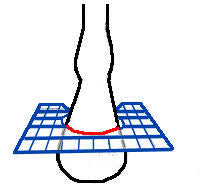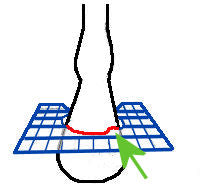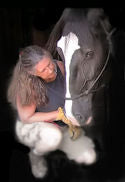The Hairline Tells It All ...
Lyle “Bergy” Bergeleen wrote a book. It’s called, “The Hairline Tells It All”. I read it way back when it first came out and embraced it full hilt. … The Hairline. And I ain’t talkin’ about the hair on our heads! (Or, lack thereof) … I’m talking about the hairline on the horse’s hoof … where horn meets hair.
It truly does talk to us.
It tells us ‘things’ … like where there’re undue pressures exerted on the hoof wall or the sole, or, if the hoof is balanced medio-laterally (side to side). It can indicate a sinking hoof. It can tell us how the coffin bone is angled IN the foot where we can’t see with our own eyes. It can speak of prior injuries and tell us how the tubules in the hoof are growing. It can tell us if an abscess is brewing or a hoof is going laminitic.
Yep, the hairline tells it all.
And, all it takes to ‘listen’ to the hairline is to view from the ground level. Yep – from on the ground. When lying flat on the ground in front of the horse (be cautious – of course we all know that horses can be unpredictable but in all the years I worked on horses I’ve never had one step on my head! I’ve had them spook and jump OVER me but still – be CAREFUL!) and take a good look at the hairline. Even when viewing from slightly ‘above’, you’ll be able to see if the hairline is parallel with the level plane of the ground.
Is it parallel to the level ground without any deviations up or down or any ‘waves’ or ‘dips’? 
If parallel to the ground that tells you that the hoof is well balanced medio-laterally. You can, also, view the length of the wall on either side of the hoof from the hairline down to the ground. Both sides should be equal in length.
You see, the hairline is malleable. It is easily affected by pressure from underneath the hoof. If there is a spot on the sole that perhaps needs to be skimmed down it will tell you in the hairline as there will be a slight ‘wave’. If you follow a ‘line’ from the center of the ‘wave’ in the hairline down to the ground you may be able to see that the wall, right there, is a tad longer than it should be OR … look under the hoof at the sole and see if perhaps there is a high spot in the sole. 
If the hairline is higher on one side of the hoof or the other then you know that you have excess wall or heel on the side that is elevated. In the case of this illustration, the right side of the hoof is higher than the left.
I think the hardest thing for trimmers to see is the DIAGONAL IMBALANCE … A Diagonal imbalance is when one heel will be taller than the other and the diagonal toe quarter will also be higher than the other quarter. The hairline may look to be perfectly parallel to the ground when viewed from above but then, when on the ground viewing it at plane level then one can see the hairline is ‘tilted’ .

Diagonal Imbalance is a complicated topic but if you want to learn more about it you can read more here: diagonal imbalance of equine hoof You'll have to read this on a PC as I've yet to finish converting my website over to a mobile-friendly format. But the illustration, I hope, is clear.
Mostly, if you've heard about a 'diagonal imbalance' from someone then that person has been or has heard the information from a PENZANCE student. This is not widely understood, imbalance of the equine hoof and most do not recognize it unless they've studied with me. It takes a good eye and someone to clearly explain it for complete understanding. Unfortunately, because of this, many hooves continue on in the same growth pattern of diagonal issues until serious imbalances cause lameness.
Understanding the hairline can absolutely help the horse owner to recognize and PREVENT hoof lamenesses before they occur.
I hope you all will inspect your horses' hooves after reading this.
Building a Supportive Barefoot Community
The team at Scoot Boot believe passionately in the barefoot horse and strive to build a supportive community of barefoot horse lovers.
Find more information about using Scoot Boots here.

Gwen Santagate is the author of "10 Secrets to Healthy Hooves" . For the last 37+ years, she has maintained healthy hooves with natural trimming on thousands of horses and specialized in pathological rehabilitation hoofcare for the last 18 years. She keeps a small herd of her own equines and continues to offer consults for horses in need.
